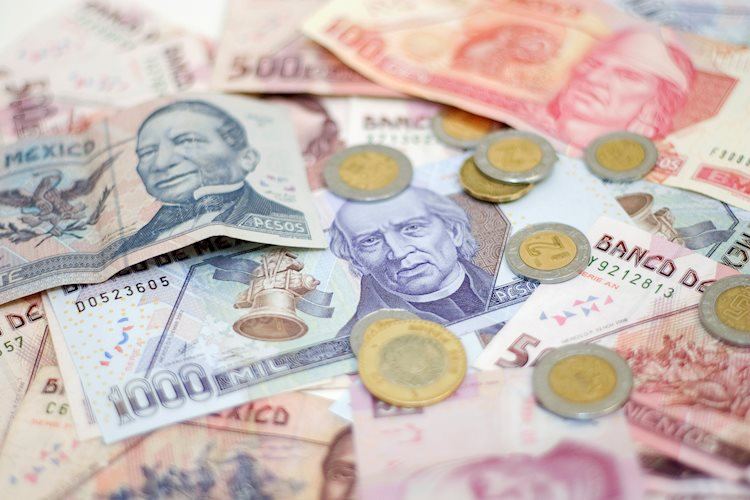- Mexican Peso pressured as Trump’s chances in the US election rise.
- Mexico’s recent economic data shows ongoing slowdown with weak Retail Sales and Economic Activity suggesting possible Banxico rate cuts.
- This week’s focus includes Mexico’s Q3 GDP, while US data releases will feature GDP, jobs data, and inflation figures.
The Mexican Peso depreciates against the US Dollar on Monday, extending its losses past the psychological 20.00 figure. The Peso is being undermined by fears of former President Donald Trump’s victory in the US election on November 5, while a tranche of Mexico’s economic data last week suggests the economy is decelerating. The USD/MXN trades at 19.99, up 0.21%.
In 2016, Donald Trump won the election, which boosted the USD/MXN from 18.60 to 20.90. However, that was just the first leg. The rally extended to 22.00 after Trump took office in January 2017. A victory for the former US President would imply imposing tariffs on Mexican imports and restrictive immigration policies, which could hurt the Mexican currency.
Polling site FiveThirtyEight shows that Trump’s odds of winning the US election have risen to 52%, against 48% for Vice President Kamala Harris. Nevertheless, the Democratic nominee remains marginally ahead in most national polls.
Bloomberg Economics reported on an analysis made last month that US federal debt may rise to 116% of Gross Domestic Product (GDP) under Trump’s tax-cut plan. Under Harris’s platform, it would be on a path to 109%.
Mexico’s Retail Sales and Economic Activity data for August were weaker than expected last week, according to INEGI. This, along with a goodish mid-month inflation report in October, could open the door for another interest rate cut by the Bank of Mexico (Banxico) at the upcoming November meeting.
The swaps market suggests Banxico will cut between 175 to 200 basis points over the next 12 months. Mexico’s central bank is expected to lower rates to 10.25% for the upcoming meeting.
Ahead of the week, Mexico’s economic schedule will feature the release of Gross Domestic Product (GDP) figures for Q3 2024, Business Confidence, and S&P Global Manufacturing PMI.
In the US, the economic docket is expected to reveal jobs data, GDP for the third quarter of 2024 on its preliminary reading, the Fed’s preferred inflation gauge, the Core Personal Consumption Expenditures (PCE) Price Index and Nonfarm Payrolls (NFP).
Daily digest market movers: Mexican Peso on the backfoot ahead of busy Mexico-US docket
- Mexico’s GDP in Q2 came at 0.2% QoQ and 2.1% YoY. If GDP for the third quarter, on a quarterly and annual basis, misses those marks, it could mean that the economy might be tipped into a recession.
- On Tuesday, the US economic docket will feature US JOLTS for September, which are expected to drop from 8.04 million to 7.99 million.
- At the same time, the Conference Board (CB) is expected to release October’s Consumer Confidence reading, which is likely to improve from 98.7 to 99.3.
- The US Bureau of Economic Analysis will reveal the GDP for the third quarter on Wednesday. Estimates suggest the economy grew 3% QoQ.
- Data from the Chicago Board of Trade, via the December fed funds rate futures contract, shows investors estimate 49 bps of Fed easing by the end of the year.
USD/MXN technical outlook: Mexican Peso tumbles as USD/MXN closes into 20.00
The USD/MXN uptrend remains intact despite consolidating near 19.70/20.00 for the last six days. Momentum remains bullish as the Relative Strength Index (RSI) depicts. This means the pair could challenge year-to-date (YTD) peaks as we get closer to November 5, US election day.
If buyers clear the 20.00 figure, they could test the last week peak at 20.09. On further strength, the USD/MXN could aim toward the YTD high at 20.22, ahead of key psychological levels of 20.50 and 21.00.
On the other hand, if sellers reclaim the October 18 low at 19.64, this could pave the way for a challenge to 19.50. The next move would be toward the October 4 swing low of 19.10 before testing 19.00.
Banxico FAQs
The Bank of Mexico, also known as Banxico, is the country’s central bank. Its mission is to preserve the value of Mexico’s currency, the Mexican Peso (MXN), and to set the monetary policy. To this end, its main objective is to maintain low and stable inflation within target levels – at or close to its target of 3%, the midpoint in a tolerance band of between 2% and 4%.
The main tool of the Banxico to guide monetary policy is by setting interest rates. When inflation is above target, the bank will attempt to tame it by raising rates, making it more expensive for households and businesses to borrow money and thus cooling the economy. Higher interest rates are generally positive for the Mexican Peso (MXN) as they lead to higher yields, making the country a more attractive place for investors. On the contrary, lower interest rates tend to weaken MXN. The rate differential with the USD, or how the Banxico is expected to set interest rates compared with the US Federal Reserve (Fed), is a key factor.
Banxico meets eight times a year, and its monetary policy is greatly influenced by decisions of the US Federal Reserve (Fed). Therefore, the central bank’s decision-making committee usually gathers a week after the Fed. In doing so, Banxico reacts and sometimes anticipates monetary policy measures set by the Federal Reserve. For example, after the Covid-19 pandemic, before the Fed raised rates, Banxico did it first in an attempt to diminish the chances of a substantial depreciation of the Mexican Peso (MXN) and to prevent capital outflows that could destabilize the country.
Read the full article here

